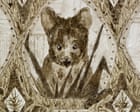
In an intriguing blend of art and nature, the Poo-tastic Tasmanian Paint Off ushers in a fresh perspective on creativity, inviting artists to explore the possibilities of animal dung as a painting medium. This unique competition, conceptualized by Karin Koch after discovering the cow dung artwork of German artist Werner Härtl, challenges artists to paint portraits of esteemed figures using natural excretions. Tasmanian artist Mel Hills has already ventured into this innovative domain by utilizing wombat and pademelon dung to create her artistic expressions, highlighting the creative potential that exists within unconventional materials and seeking to demystify the dialogue around waste.
As artistic enthusiasts consider the nuanced dimensions of dung-inspired art in Tasmania, residents of Sydney and New South Wales are advised to prepare for inclement weather. The Bureau of Meteorology forewarns of a potent weather system brewing off the east coast of Australia, anticipated to bring potentially damaging winds and substantial rainfall early in the coming week. This atmospheric disturbance, likely culminating in an east coast low, could lead to both flash and river floods, presenting a challenge to communities within and around Sydney, particularly on Tuesday and Wednesday. Residents are encouraged to stay informed and take necessary precautions to safeguard against the pending meteorological events.
Meanwhile, a thoughtful exploration is underway at the Manchester Museum, where the moral and ethical implications of displaying ancient human remains are being reconsidered. As part of its decolonization initiative, the museum has reached out to the public to gather opinions on whether the 2,700-year-old remains of Asru, an Egyptian woman from Thebes, should continue to be exhibited. This introspective dialogue aligns with the museum’s ongoing efforts to modernize its collections and practices, ensuring they reflect contemporary ethical standards and sensitivities.
Across the Atlantic, the operational dynamics within the US Centers for Disease Control and Prevention (CDC) invite reflection on internal leadership structures. Robert F. Kennedy Jr.’s direct involvement signifies a notable shift in administrative procedures, especially given the absence of an official CDC director. His influence allows for a decision-making presence that extends to significant facets such as vaccine recommendations, though the actual degree of control and influence remains complex and is subject to scrutiny and discussion in broader governmental and public health contexts.
On a social and economic front, a recent barometer by the Observatory of Gender, Labor, and Power reveals an illuminating snapshot of gender distribution within various professional fields. The data underscores the predominance of women in care-related sectors—including personal care, cleaning, healthcare, and education—while identifying a sparse female workforce within industries such as forestry and metallurgy. This gender landscape invites discussions on the social and structural factors influencing occupational trends and highlights areas for potential policy and cultural advancement to foster balanced workforce representation.
Each of these stories presents a unique dimension of contemporary life—from innovative art practices and weather preparedness to ethical museum curation and workplace gender dynamics. As we engage with these diverse narratives, we are reminded of the shared endeavors that weave the multifaceted tapestry of our global community, where creativity, preparedness, ethical reflection, and social progress continue to engage and inspire us.
Source: {link}
